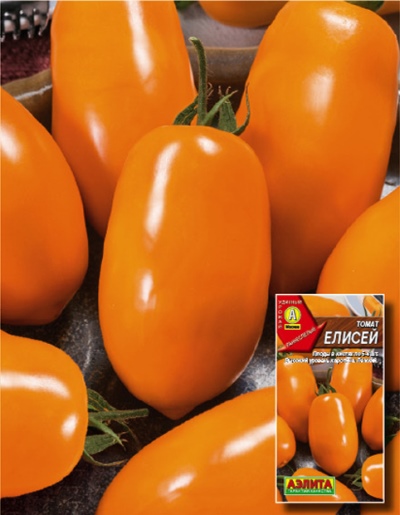
- Authors: Nastenko N.V., Kachainik V.G., Kandoba A.V. (Agrofirma Aelita LLC)
- Year of approval: 2008
- Category: grade
- Growth type: determinant
- Appointment: fresh consumption, for whole fruit preservation
- Ripening period: early
- Ripening time, days: 95-105
- Growing conditions: for open ground, for film greenhouses
- Bush size: undersized
- Bush height, cm: up to 70
Tomato Elisey, despite its emphatically "sublime", "fabulous" name, is capable of becoming an attractive garden culture in practice. However, only those farmers who prepare properly for planting and growing will not be disappointed in it. Therefore, objective information about such a variety is of particular relevance.
Breeding history
The culture was created at the breeding facilities of Agrofirma Aelita LLC. The main employees in the project were the breeders Kachainik, Nastenko and Kandoba. They carried out the work program during the 2000s. In 2008, this variety was officially approved for cultivation in private gardens.
Description of the variety
Elisha is a typical determinant. You can see it both in open areas and in greenhouses with film insulation. The bushes will be low. Even the most developed of them grow only up to 0.7 m.The plant is zoned for:
- West Siberian and Moscow Region;
- East Siberian and Far Eastern;
- black earth;
- North Caucasian;
- Volgo-Vyatka;
- lower Volga;
- middle Volga;
- North Russian vegetable gardens.
The foliage is medium in size. A simple green color is typical for her. Skilled and diligent gardeners do not have any special problems with the cultivation of Elisha. Planting is even possible directly into the soil. In this case, it is recommended to create a simple film cover; the use of growth promoters is also desirable.
The main qualities of the fruit
Early unripe berries will have a light green color. Elisha's ripe harvest takes on an orange color. The mass of a single specimen ranges from 0.05 to 0.06 kg. As part of the brush, on simple inflorescences, 5 or 6 tomatoes are formed. They are covered with a flawlessly smooth skin.
Taste characteristics
Elisha berries are good ready-made. You can also use them for canning - as whole fruits. This moment will especially appeal to those who like to use the harvest of tomatoes on the festive table.
Ripening and fruiting
This variety is notable for its early ripening period. For the development of berries after the release of greens, it will take from 95 to 105 days. Harvesting will be possible in July and August. The important thing is that fruiting is long lasting and quite effective.
Yield
Suppliers of planting material mention that the collection from 1 sq. m. can reach 8.5 kg. Naturally, this result is achieved only under favorable weather conditions. Competent agricultural technology is also important, which can sometimes compensate for individual "flaws" of the weather regime.
The timing of planting seedlings and planting in the ground
Sowing seeds in containers should be done no earlier than March 20. It should be roughly completed by April 10th. The time for transplanting mature seedlings into the ground falls on May 15 - June 5. Of course, due to weather conditions, it is often necessary to make adjustments to this schedule. The actual readiness of the seedlings themselves to work is also taken into account.

Growing tomato seedlings is an extremely important process, because it largely depends on whether the gardener can harvest at all. All aspects must be taken into account, from seedbed preparation to planting in the ground.
Landing scheme
Landing on the 500x400 mm system is welcome. Placing more than 5 plants on 1 "square" is hardly justified. Better to limit yourself to 4 bushes altogether. Then there will be no mutual interference due to the interlacing of the roots and difficulties in leaving.

Growing and care
The Elisey variety requires a fairly scrupulous care. In any case, he needs a garter and the removal of his stepsons. It will also be impossible to do without shaping, because otherwise the bush will begin to develop incorrectly. Verticillosis and fusarium wilting practically do not affect such tomatoes. But certain preventive measures will still need to be carried out.
Do not be overly deceived by the cold resistance of such a culture. Without careful cover, it will hardly be able to withstand the return of cold weather and early frosts. Shelter measures are the same as for other tomatoes.




A plant needs different micronutrients at each stage of growth. All fertilizers can be divided into two groups: mineral and organic. Folk remedies are often used: iodine, yeast, bird droppings, eggshells.
It is important to observe the rate and period of feeding. This also applies to folk remedies and organic fertilizers.



























































































